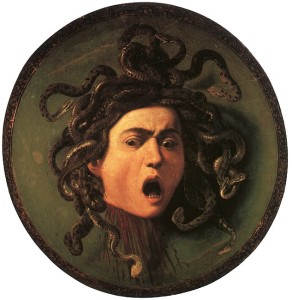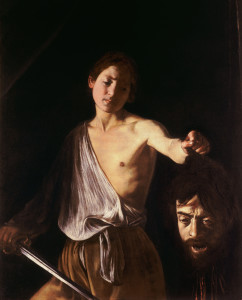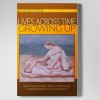In general, Caravaggio imbricates the profane with the sacred, just as he creates a duet between light and dark. With light and dark, he technically uses the extremes of visual world to amplify, intensify the portrayal of reality, to enhance reality so that it feels real.14 By employing the extremes of the visual, he also enhances the shades and colors between these extremes. So too for the sacred and profane. Previous artists separated the profane from the sacred representations, or made almost didactic use of the sacred to distinguish it from the profane: for instance, in the passion of Christ, artists made it clear who was evil, those who lashed him, or speared his side. Even the master, Michelangelo in his Sistine Chapel’s Last Judgement, the artist makes it clear who – beneath Christ’s feet – is going to or in Hell, and who are the beatified en route to Heaven. No room for ambiguity.15 Caravaggio in contrast adds ambiguity, shades of judgment about the profane and sacred. First, he brings the profane into sacred representations, such as the portraits of contemporary laborers in their worship of Mary. Second, as mentioned above, he portrays the “sacred” acts of Judith or David with greater subtleness. Third he plays with portrayals of sacred characters, such as the almost teasing, lounging, perhaps louche, St. John, his satisfied smile almost a twin to Caravaggio’s Baccus. Caravaggio’s introduction of ambiguity – via light/dark; via sacred /profane – leads to a greater appreciation of the fullness and complexity of emotional life, the “shades” between darkness and light.
Further, Caravaggio’s elevation of the mundane or profane into the aesthetic or sacred is similar to early Christianity’s elevation of the worldly to the divine as captured in Matthew’s “one (sparrow) shall not fall on the ground without your Father.” In this sense, Caravaggio challenges the Church of his time, engorged with wealth and corruption, to live up to its early dedication to the downtrodden.
For Caravaggio, when people are together, they are together intensely and often with murderousness enacted or in the air. Murder’s presence is clear in portraits such as Judith and Holofernes, David and Goliath, even Abraham and Isaac. Caravaggio’s portrayals of Christ show either violence (flagellation, thorn-crowning) or implicit violence in the passion, albeit with Christ appearing indifferent, neutral, possibly saddened or resigned in some cases. While his Christs do not differ in this sense from other artists, Caravaggio pushes the degree to which death and decay are present and to which when people become close, murder or death enters. In psychoanalytic terms, Caravaggio recognizes and portrays the presence of ambivalence and ambiguity between people, particularly when emotions run high. Freud’s (1923) recognition of ambivalence in our intense, intimate relationships is one of his major contributions. Caravaggio, perhaps among others, identifies this visually some three hundred years earlier.
Caravaggio’s “graphical autobiographical” notes about himself also are not new: previous artists would insert themselves, for instance as an observer in a crowd. In one of Michelangelo’s last sculptures, a Pieta for his tombstone, he puts his face into that of ancient Nicodemus, poised above both Christ and Mary, supporting the fallen son.16 But Caravaggio takes us and himself much further into the intense moment. We see only Medusa’s severed head – no Perseus present — snakes writhing in death throes, but it is Caravaggio’s visage, eyes and mouth wide-open, showing more fear than anger glaring at us. Or, in Judas’ kiss, soft embrace and betrayal of Christ, others are charged with emotion – a Roman soldier rushing to grab the revolutionary, a citizen turned away from Christ in shock, others crowded about, while at the right edge, arm aloft with light upon the scene, is the artist, mouth and eyes alert with interest, perhaps a touch of surprise. Caravaggio crowds us towards the central scene; he is a parenthesis to the moment. Finally, his near- death portrayal of David and Goliath is another stark portrayal of himself. We can compare this to Bernini’s David sculpture: victorious, muscular and fiercely, angrily expressive — a look of fiero –he swipes his blade through. But, Caravaggio, now in his early 40’s, running from justice for years, portrays something more complex. Yes, his face is in the severed skull of Goliath. Even in death, Caravaggio/Goliath’s upper face shows “corrugator action, which Darwin called the muscle of difficulty — seen also in pain, anger, fear, and sadness. His lower face is mouth agape.
But, we can treat the picture like a dream in which the artist (or the dreamer) can parcel himself into several characters, as Freud (1900) and Erikson (1954) taught us. Then, to the degree that this David is Caravaggio’s David, the young shepherd’s face shows no fiero, no anger, no joy: he looks, head tilted, slightly downward to his left, towards the dangling head held by his almost soft grasp. He shows remarkable calm, but with a tone of sadness or remorse or pity in the brows of the victor’s face. That is, Caravaggio in his penultimate work both somberly metes out justice (David) and is met with justice (Goliath).
Footnotes
14 We refer here to Auerbach’s (1954) elaboration of Aristotle’s idea of the artist’s responsibility of mimesis: to re-present external reality so that it feels real to the audience.
15 In contrast, Dante adds ambiguity to those damned to Hell. When he meets the lovers Paolo and Francesca hovering, he hears their tale with such compassion, that he faints.
16 Allegedly, the aged Master was so dissatisfied with this piece that one evening he took a hammer to it, only to be stopped by a friend. He had compared it to the Pieta he made when in his mid-20’s. The piece was not used for Michelangelo’s grave, but sits in a rotunda in Rome.





